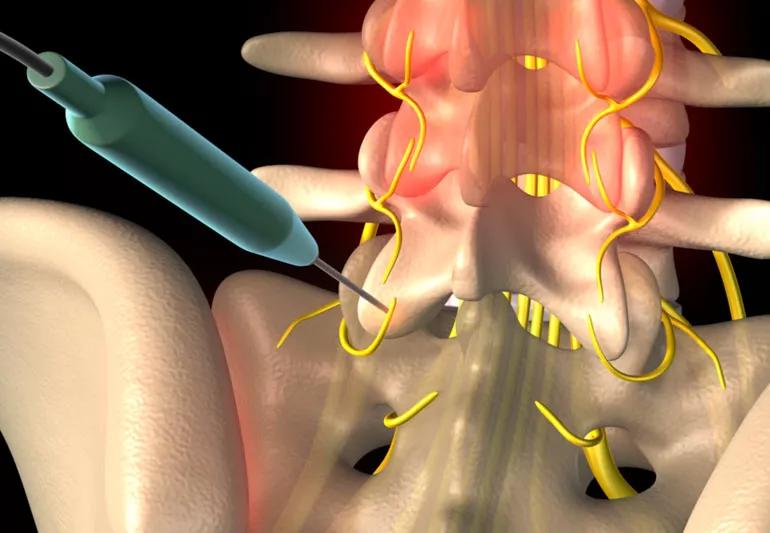A minimally-invasive approach to neck and back pain

If you suffer from chronic neck or chronic lower back pain, there is a minimally-invasive option, called radiofrequency ablation (RFA), that you may want to discuss with your doctor. For some patients, RFA may reduce or eliminate pain for months at a time.
Advertisement
Cleveland Clinic is a non-profit academic medical center. Advertising on our site helps support our mission. We do not endorse non-Cleveland Clinic products or services. Policy
During the RFA procedure, your doctor will numb the area with a local anesthetic then insert a small needle into your skin near the affected area. A special X-ray machine, called a fluoroscope, is used to precisely guide the needle to nerves that relay pain to the back or neck. Radio waves are then channeled through the needle, producing low-grade heat near those nerves that cause pain. This heat decreases the ability for those nerves to give pain signals from a specific area that’s causing you chronic pain, like your neck or back.
“As we age, the joints in the neck and back are more likely to develop arthritis, which can result in chronic pain,” says pain management specialist Teresa Dews, MD. She says RFA can help provide patients long-term relief.
Dr. Dews doesn’t recommend using solely RFA to manage pain. Rather, it’s most effective as part of a comprehensive approach. “There are other things people can and should do to manage and relieve chronic pain,” Dr. Dews says. “These include increasing their activity level, using good body mechanics and posture, stress management, and getting good duration and quality sleep. It is also important to achieve and maintain a healthy weight with a healthy diet that minimizes highly processed foods.”
Advertisement
For example, your pain treatment plan could start with various exercises, yoga and water therapy. But if you need additional intervention to address your specific pain, exploring RFA is a good option. The results of RFA vary, lasting on average from three to six months, and in some cases up to a year.
Psychological tools (such as relaxation and stress management techniques) and non-narcotic medications are also options for treating chronic pain, along with interventional procedures like nerve blocks, of which RFA is one type. According to Dr. Dews, “for many patients, the best solution utilizes a combination of all of these pain management tools.”
The procedure is relatively simple and typically covered by insurance. While the procedure may vary by medical center, here is how it’s generally performed.
First, your pain specialist will review your medical history and complete a physical exam. If you’re a candidate for RFA, you’ll undergo a diagnostic nerve block. This stops nerve function in the area for a short time, similar to how a dentist uses Novocain®. If the temporary nerve block works to relieve your pain, then it tells the doctor that RFA is a viable option for longer-term pain relief.
Prior to the RFA treatment, you must fast for six hours and may need to adjust any other medications you take on a regular basis.
On the day of the procedure:
The procedure takes about 30 to 40 minutes, followed by a 15-minute recovery period during which your vital signs, like blood pressure and pulse, are monitored. You may then return home with the assistance of a responsible adult driver, as driving isn’t permitted after having an RFA procedure. You can return for a follow-up visit in 8-12 weeks.
You may have some minor discomfort shortly after an RFA procedure, but should be able to return to your normal activities within 24 hours.
Common side effects after an RFA procedure are:
Advertisement
Radiofrequency ablation is usually covered by insurance, and for those experiencing chronic neck or back pain, RFA can be a welcomed relief. Remember: For the best outcome, follow your doctor’s recommendations.
Advertisement
Learn more about our editorial process.
Advertisement

Non-surgical ways to help you function better

Most recommended precautions center around minimizing bruising or swelling

Even one drink can have an impact on your cognitive function leading to slurred speech, blurred vision and impaired memory

Understand who may (and may not) benefit

Lorem ipsum dolor sit amet. Et odio Quis vel ipsam omnis eum alias deleniti et placeat impedit non voluptas galisum hic autem enim et cupiditate aliquid. Est beatae quidem non facilis autem ut commodi nisi aut tempore rerum et dolores voluptatem cum enim optio id sapiente quasi. Ad laboriosam officiis 33 cupiditate sequi ea voluptatum consectetur qui necessitatibus voluptate et quasi doloremque et facere explicabo quo explicabo officia

Seeking help through therapy can be an important step in improving your quality of life when you have UC

Type 2 diabetes isn’t inevitable with these dietary changes

Applying a hot or cold compress can help with pain